Have you ever wondered what architectural treasures lie within the Basque Country? Step into a world where medieval structures blend with modern marvels, where each corner holds a unique story waiting to be discovered. From the grandeur of gothic splendor to the sleek lines of contemporary innovations, this photographic journey will explore the Basque Country’s architectural wonders.
Prepare to be captivated by the intricate details of medieval masterpieces, the awe-inspiring beauty of Renaissance revival, and the extravagant elegance of baroque. But that’s not all – we will also unveil the hidden gems of industrial architecture and the groundbreaking designs of modernist marvels, leaving you hungry for more. Get ready to embark on a visual adventure that will transport you through time and space as we uncover the most beautiful architectural wonders in the Basque Country that are truly unique.
Medieval Masterpieces in the Basque Country
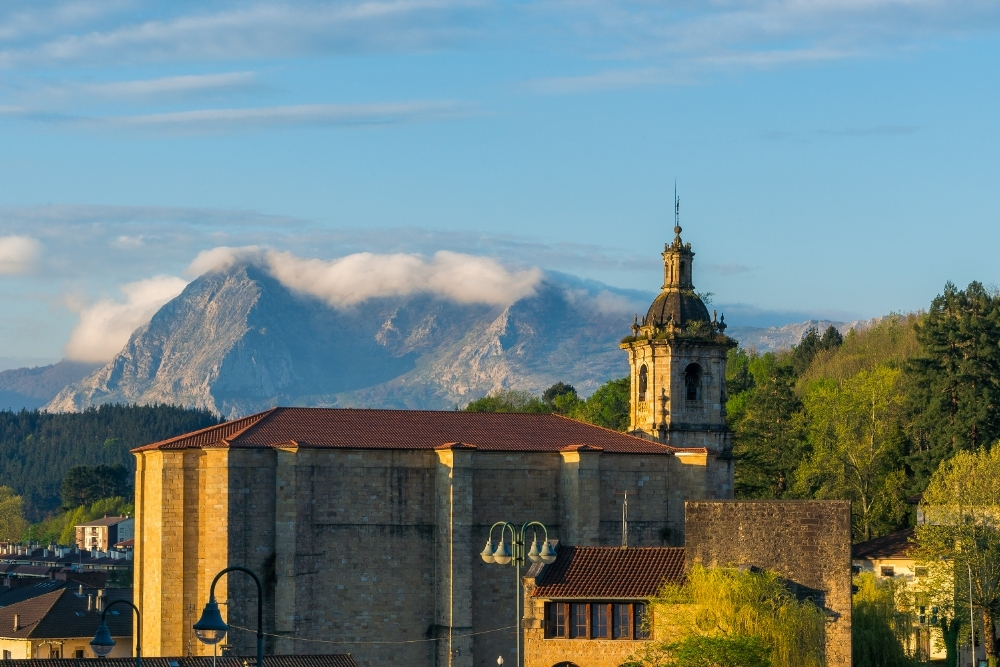
The medieval masterpieces in the Basque Country are a testament to the region’s rich architectural heritage and skilled craftsmanship. The fortified castles that dot the landscape are reminders of a time when security and protection were of utmost importance. With their thick stone walls and strategic positioning, these structures were designed to withstand attacks and provide a safe haven for their inhabitants.
The Tower of Mendoza (Torre de Mendoza) in Álava:
- Located in the province of Álava, the Tower of Mendoza is a prime example of medieval military architecture in the Basque Country.
- Built in the 13th century, this fortress tower was a part of the region’s defensive system and belonged to the powerful Mendoza family.
- It’s known for its five floors and the surrounding wall with three towers at the corners, showcasing the typical defensive features of medieval fortifications.
- The Tower of Mendoza played a significant role in the territorial disputes of medieval Spain and now stands as a symbol of the region’s historical conflicts and power dynamics.
The Fortress of Butrón (Castillo de Butrón) in Gatica, Biscay:
- This medieval castle, located near Bilbao in the province of Biscay, dates back to the Middle Ages, with its origins in the 11th century.
- The fortress has undergone various modifications over the centuries, but it retains a distinctly medieval character with its drawbridge, moat, and imposing towers.
- Butrón Castle is unique due to its picturesque and fairy-tale appearance, which is a result of a 19th-century renovation in a romanticized neo-Gothic style.
- Although not historically accurate in its current form, the castle provides an imaginative representation of medieval architecture and has become a popular tourist attraction.
The Walls of Hondarribia (Murallas de Hondarribia) in Gipuzkoa:
- Hondarribia’s city walls are a remarkable example of medieval fortifications in the Basque Country.
- Constructed between the 12th and 16th centuries, these walls were essential for defending the city against various sieges throughout history.
- The walls, along with their gates and bastions, outline the old part of the city and give Hondarribia its distinctive historical character.
Gothic Splendor in the Basque Country
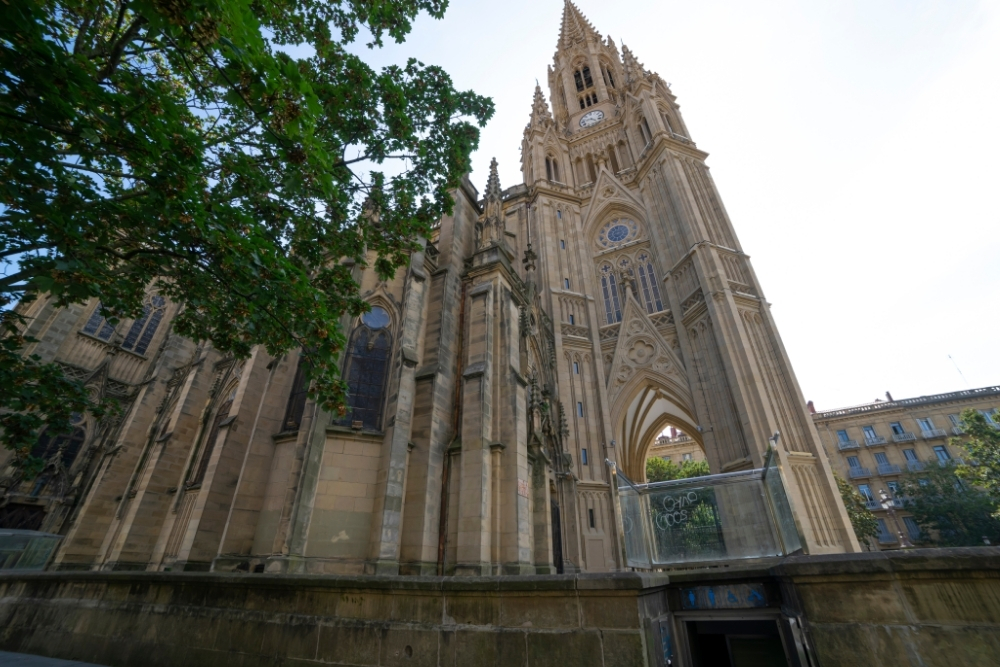
Continuing our exploration of the architectural wonders in the Basque Country, we now turn our attention to the breathtaking Gothic splendor that graces the region. The Basque Country is home to numerous Gothic cathedrals and medieval castles, each showcasing this architectural style’s grandeur and intricate details.
Cathedral of Santa María de Vitoria:
- – Located in Vitoria-Gasteiz, the capital city of the Basque Autonomous Community, this cathedral is a prime example of Gothic architecture in the region.
- – Construction began in the late 13th century and continued through the 14th century.
- – It’s famously known as the “Open Cathedral” due to its long-term restoration project, which allows visitors to see the ongoing work and learn about the building’s history and architecture.
- – The cathedral has a unique lantern tower, which is rare in Spanish Gothic architecture, and features remarkable Gothic sculptures and stained glass windows.
Church of San Vicente, San Sebastián:
- – This church, situated in the Old Town of San Sebastián, Gipuzkoa, is the oldest church in the city, dating back to the 16th century.
- – Its construction showcases the typical Gothic style with a hall church layout, characterized by having a nave and aisles of approximately equal height.
- – The church contains a valuable altarpiece by Ambrosius Benson, a Flemish painter of the Renaissance, and various Gothic sculptures and artworks.
- – The Church of San Vicente played a significant role in the religious and social life of San Sebastián throughout history.
Basilica of Santa María del Coro, San Sebastián:
- – Also located in San Sebastián, this basilica is an excellent example of the transition from Gothic to Baroque architecture.
- – The church was built on the site of a Roman temple and later a medieval church, with the current structure dating from the late 16th to the early 18th century.
- – It features a prominent Baroque façade, but the interior remains largely Gothic, with ribbed vaults and a high altar.
- – The Basilica of Santa María del Coro is noted for its intricate wooden choir stalls and the image of the Virgin of the Choir, an important religious icon in the city.
Renaissance Revival in the Basque Country
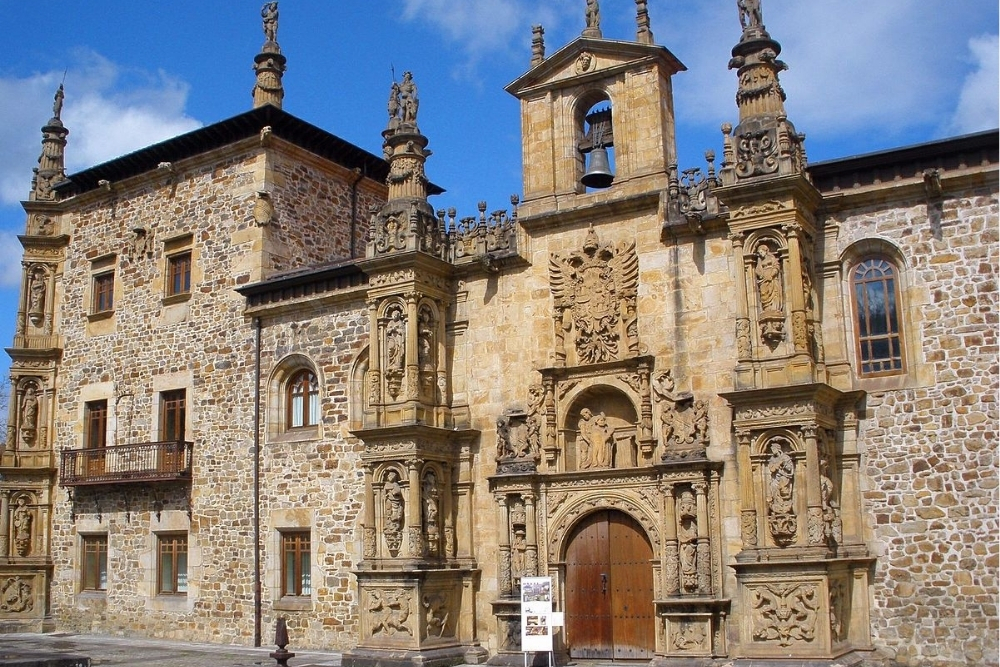
With its rich cultural heritage and architectural prowess, the Basque Country also boasts a remarkable display of Renaissance Revival buildings that showcase the region’s artistic and intellectual reawakening. The Renaissance Revival movement, which emerged in the 19th century, sought to revive the architectural styles of the Italian Renaissance. In the Basque Country, this movement was marked by a commitment to architectural preservation and a desire to revive the grandeur and elegance of the Renaissance period.
The University of Oñati (Universidad Sancti Spiritus):
- – Located in Oñati, Gipuzkoa, this building was constructed in the 16th century.
- – It’s an excellent example of Basque Renaissance architecture, showcasing a plateresque style, which is characterized by intricate, detailed decorative motifs.
- – The university was founded by Bishop Rodrigo Mercado de Zuazola and has a notable cloister and a beautiful façade.
- – It served as a university until the 20th century and now houses the Institute of Basque Studies and the Oñati International Institute for the Sociology of Law.
The Palace of Montehermoso (Palacio de Montehermoso):
- – This palace is situated in Vitoria-Gasteiz, the capital city of the Basque Autonomous Community.
- – Built in the 16th century, the palace combines Renaissance and Gothic elements.
- – It’s particularly known for its elegant façade and the impressive staircase inside.
- – The palace has been restored and is currently used as a cultural center, hosting various exhibitions and cultural activities.
The Fuenterrabía (Hondarribia) Town Hall:
- – Located in the town of Hondarribia in Gipuzkoa, the town hall was originally a castle built in the 10th century and transformed into a Renaissance building in the 16th century.
- – It features a remarkable façade with a mix of late Gothic and Renaissance elements.
- – The building is noted for its arched gallery and ornate wooden eaves.
- – Today, it still serves as the town’s administrative center and is a point of interest for visitors to Hondarribia.
Baroque Extravaganza in the Basque Country
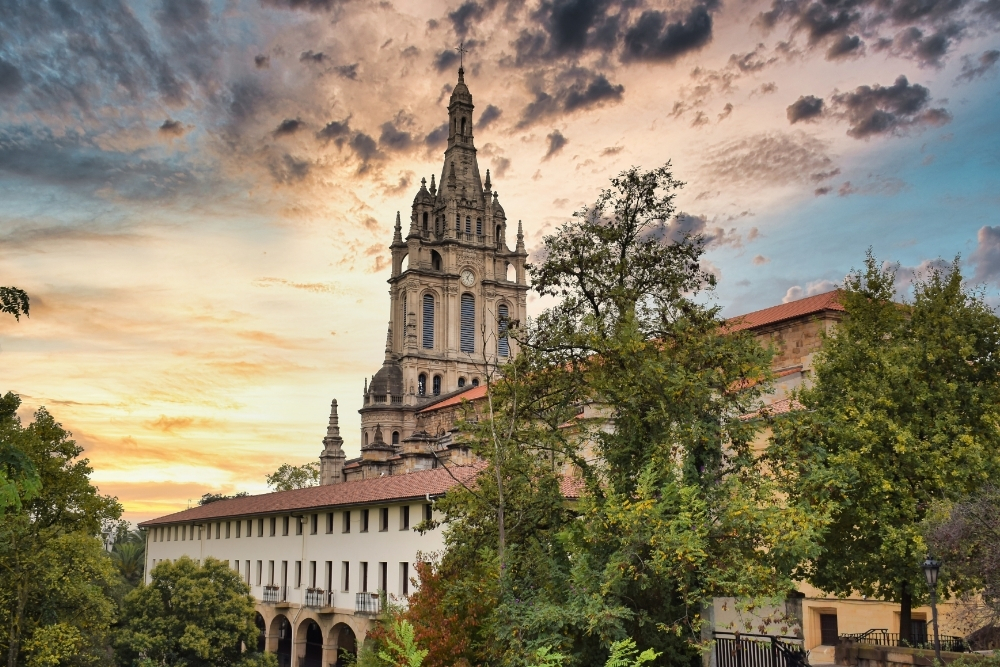
Characterized by its ornate and extravagant style, the Baroque era in the Basque Country brought forth a remarkable display of artistic expression through its architecture. The Baroque Extravaganza is a testament to the artistic opulence and ornate details that defined this period.
Basilica of Our Lady of Begoña, Bilbao:
- Situated in Bilbao, this basilica is dedicated to the patron saint of Biscay, the Virgin Begoña.
- Construction of the church began in the early 16th century, but it embodies the Baroque style in its later additions and renovations, particularly noticeable in its impressive façade completed in the 17th century.
- The basilica has a Latin cross layout and features a magnificent high altar, an exquisite example of Baroque goldsmithing.
- It’s a significant religious and cultural symbol in Bilbao, especially during the festivities of the Big Week of Bilbao, where it plays a central role.
Church of San Nicolás, Bilbao:
- Also located in Bilbao, the Church of San Nicolás is a fine example of Basque Baroque architecture, dating back to the mid-18th century.
- It was built in honor of Saint Nicholas, the patron saint of sailors, reflecting Bilbao’s maritime history.
- The church is notable for its impressive dome, which is visible from various points in the city and its elliptical floor plan, which is somewhat unique among Basque churches.
- The interior features an ornate altar and several Baroque sculptures and paintings.
Sanctuary of Loyola, Azpeitia:
- This sanctuary, located in Azpeitia, Gipuzkoa, is part of a larger complex that includes a basilica and a monastery. It is famously known as the birthplace of St. Ignatius of Loyola, the founder of the Jesuit order.
- The construction of the sanctuary began in the 17th century and is a masterpiece of Baroque art and architecture.
- Its most striking feature is the ornate Churrigueresque façade and the spectacular dome.
Modernist Marvels in the Basque Country
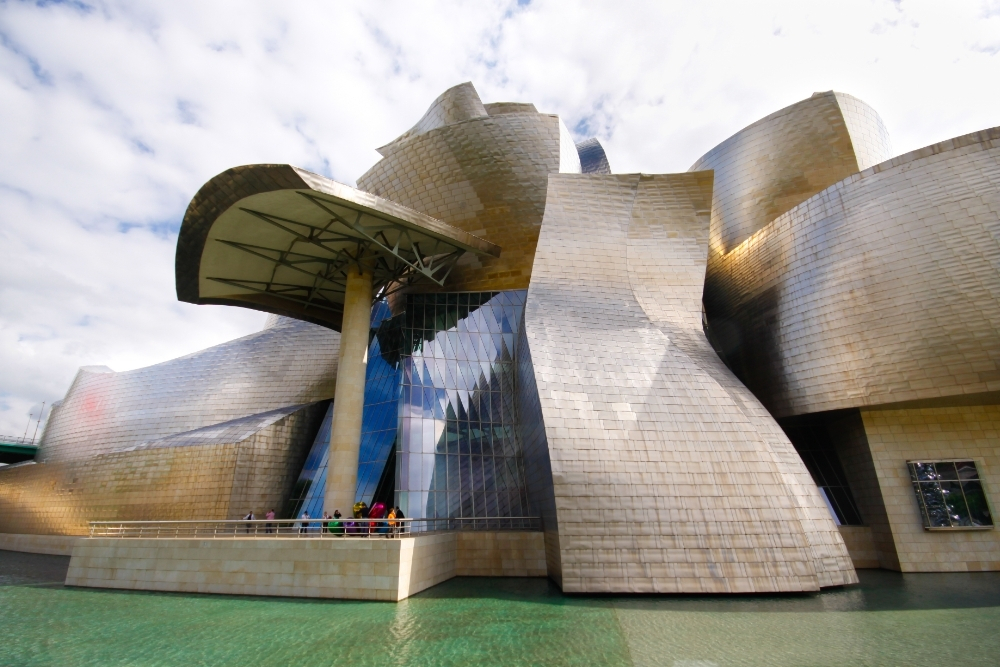
Immerse yourself in the captivating world of modernist marvels as you explore the architectural gems that adorn the Basque Country. The Basque region boasts a rich collection of modernist structures that exhibit minimalist designs and sustainable principles. These buildings, characterized by their clean lines and functional aesthetics, embody the spirit of modernism and the Basque people’s commitment to sustainability.
Guggenheim Museum in Bilbao:
- Designed by the renowned architect Frank Gehry, the Guggenheim Museum in Bilbao is a masterpiece of 20th-century architecture.
- Opened in 1997, this museum is famed for its innovative design, featuring titanium, glass, and limestone, which creates a dynamic, sculptural form that changes appearance with light.
- The museum played a significant role in the revitalization of Bilbao, leading to what is often referred to as the “Bilbao Effect,” a phenomenon where a city undergoes economic and cultural revitalization through iconic architecture.
- It houses a collection of modern and contemporary art and has become one of the most visited attractions in the Basque Country.
Kursaal Congress Centre and Auditorium in San Sebastián:
- Designed by Spanish architect Rafael Moneo, the Kursaal Congress Centre and Auditorium exemplifies cutting-edge contemporary architecture.
- Completed in 1999, the building consists of two large cubes made of translucent glass, which are meant to resemble two beached rocks.
- The Kursaal is a multi-purpose venue hosting various events, including the famous San Sebastián International Film Festival.
- Its striking modernist design contrasts with the more traditional architecture of San Sebastián, making it a symbol of the city’s modern cultural identity.
Alhóndiga Bilbao (now known as Azkuna Zentroa):
- Originally a wine warehouse, this early 20th-century building was transformed into a multi-purpose venue by the visionary French designer Philippe Starck.
- The renovation, completed in 2010, retained the original structure but completely reimagined the interior, resulting in a unique blend of historical architecture and modern design.
- The center features a cinema, a fitness center, multiple exhibition spaces, and a library, all centered around a spectacular atrium with 43 whimsical columns, each with a different design.
- Azkuna Zentroa is a cultural hub in Bilbao, reflecting the city’s commitment to contemporary art and design.
Final Thoughts on the Architectural Wonders in the Basque Country
Now that you’ve explored the architectural wonders of the Basque Country, you’re probably feeling a mix of awe and envy. Who wouldn’t want to live in a place where medieval masterpieces, gothic splendor, and modern marvels coexist in perfect harmony? It’s almost unfair how the Basque Country effortlessly blends history and innovation, leaving the rest of us longing for such architectural brilliance. So, if you’re ready to embrace a land where every corner is a feast for the eyes, pack your bags and prepare to be amazed.




